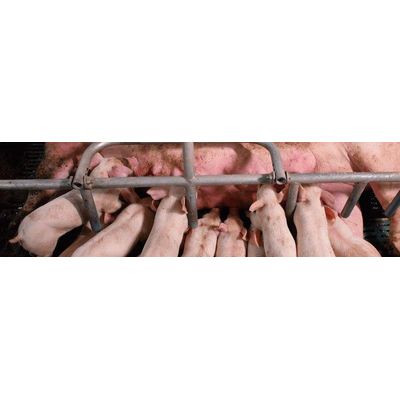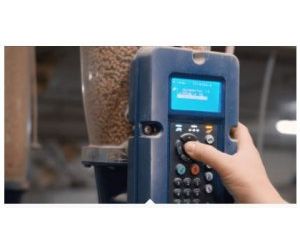

- Home
- Companies
- Jyga Technologies
- Articles
- Farrowing feeding for sow production: ...

Farrowing feeding for sow production: What to consider to improve profitability and productivity
Feeding a Farrowing Sow: What Should we Consider?
From feeder costs to feed palatability, here are some of the hot topics to think about when you are choosing the right sow feeding system for your farrowing rooms.
Farrowing Feeding Methods
Farrowing sows play an essential role in pig production since sow and litter performance can influence the swine industry’s next outcomes. Considering that, management strategies during farrowing must be conducted based on effective protocols and consider multiple factors that can impact sow performance, including nutrition, housing, health, environment, genetics, and others (Kraeling and Webel, 2015).
Although swine nutrition and its effects on farrowing sow performance have been highly investigated by the scientific community (Serena et al., 2009; Feyera et al., 2018), some concerns arise regarding how to implement those diets from a practical standpoint. Thus, discussions about swine nutrition go further than diet formulation and include the different feeding systems that can influence pig performance and farrowing management.

Besides the advantages and disadvantages within all feeding systems, it’s important to highlight that the best feeder is the one that better fits the farm management protocols and demands. The main advantage of hand-feeding is that the system/equipment is cheaper. However, that advantage is questioned from a management standpoint since hand-feeding systems require extra labor, increasing employees’ demand. On the other hand, electronic feeders allow a higher decision-making power for sow farm managers, including, to list a few, improvements in sow performance and optimization of feed and water usage.
Leading the electronic feeding segment, Gestal offers multiple options for farrowing feeders that fit the most specific farms’ needs. Standalone smart feeders from Gestal are compatible with every type of building, require minimal energy levels, and represent one of the best precision feeding technologies on the market. Herd management also gets more accessible and effective by simple and user-friendly software and mobile applications with real time monitoring.
Therefore, that decision-making driven by data acquisition and analysis provided by smart feeders goes further than feed behavior assessment. It also positively impacts the sow and piglets’ health assessment, animal welfare, farm profitability, and overall management performance, which is crucial to keep swine farms competitive in the market.
Cabezón, F. A., Schinckel, A. P., León, Y. L., & Craig, B. A. (2017). Analysis of lactation feed intakes for sows with extended lactation lengths. Translational Animal Science, 1(1), 1.
Cools, A., Maes, D., Decaluwé, R., Buyse, J., van Kempen, T. A., Liesegang, A., & Janssens, G. P. J. (2014). Ad libitum feeding during the peripartal period affects body condition, reproduction results and metabolism of sows. Animal reproduction science, 145(3-4), 130-140.
Feyera, T., Pedersen, T. F., Krogh, U., Foldager, L., & Theil, P. K. (2018). Impact of sow energy status during farrowing on farrowing kinetics, frequency of stillborn piglets, and farrowing assistance. Journal of animal science, 96(6), 2320-2331.
Gourley, K. M., Swanson, A. J., Royall, R. Q., Woodworth, J. C., DeRouchey, J. M., Tokach, M. D., … & Hastad, C. W. (2020). Effects of timing and amount of feed prior to farrowing on sow and litter performance under commercial conditions. Kansas Agricultural Experiment Station Research Reports, 6(10), 1.
Kraeling, R. R., & Webel, S. K. (2015). Current strategies for reproductive management of gilts and sows in North America. Journal of Animal Science and Biotechnology, 6(1), 1-14.
Lawlor, P. G., & Lynch, P. B. (2007). A review of factors influencing litter size in Irish sows. Irish Veterinary Journal, 60(6), 1-8.
Lynch. P. B. (2001). Factors affecting voluntary feed intake in the sow during lactation period. PhD Diss. National University of Ireland, Dublin, Ireland.
Menegat, M. B., DeRouchey, J. M., Woodworth, J. C., Dritz, S. S., Tokach, M. D., & Goodband, R. D. (2019). Effects of Bacillus subtilis C-3102 on sow and progeny performance, fecal consistency, and fecal microbes during gestation, lactation, and nursery periods. Journal of animal science, 97(9), 3920-3937.
Obermier, D. R., Knauer, M., Graham, A., & Frobose, H. (2019). PSII-12 The effects of lift crates on sow performance and litter survival. Journal of Animal Science, 97(Supplement_2), 233-234.
Peng, J. J., Somes, S. A., & Rozeboom, D. W. (2007). Effect of system of feeding and watering on performance of lactating sows. Journal of animal science, 85(3), 853-860.
Peterson, B. A., Ellis, M., Wolter, B. F., & Williams, N. (2004). Effects of lactation feeding strategy on gilt and litter performance. Journal of Animal Science, 82, 65-65.
Piñeiro, C., Morales, J., Rodríguez, M., Aparicio, M., Manzanilla, E. G., & Koketsu, Y. (2019). Big (pig) data and the internet of the swine things: a new paradigm in the industry. Animal Frontiers, 9(2), 6-15.
Serena, A., Jørgensen, H., & Bach Knudsen, K. E. (2009). Absorption of carbohydrate-derived nutrients in sows as influenced by types and contents of dietary fiber. Journal of animal science, 87(1), 136-147.
Thomas, L. L., Gonçalves, M. A., Vier, C. M., Goodband, R. D., Tokach, M. D., Dritz, S. S., … & DeRouchey, J. M. (2018). Lessons learned from managing electronic sow feeders and collecting weights of gestating sows housed on a large commercial farm. Journal of Swine Health and Production, 26(5), 270-275.
Farrowing Feeding Methods : How Was it Done 20 Years Ago?
Feeding systems for farrowing sows have been updated during the last years. Up until two decades ago, hand-feeding sows were part of all farmers’ job routines since it was the conventional way to distribute feed in the farrowing rooms. On traditional or small farms, feeding sows by hand is still common. In this type of feeding strategy, decision-making mainly relies on observation and personal experience: the person responsible for feeding the animals must check the sow’s feeding behavior and decide how much feed needs to be added based on the previous meal results.
Farrowing Feeding Methods: How is it Done Now?
The swine industry has gradually invested in feeder options that changed how to manage sow feed intake from an observational standpoint to data collection and analysis. With different technology levels, engineered feeders have become an alternative to hand-feeding, from automatic feeders based on spirals or chains (dispensers) to electronic-based feeders that can register in real time the volume and weight of feed delivered to the farrowing sow (Thomas et al., 2018).
Automatic feeders are used to ensure ad libitum feeding (full-fed systems). In this system, sows can eat when they are hungry with no restriction of feed amount. Like the Gestal smart feeders, some sophisticated electronic systems allow for on-demand ad libitum feeding, thus improving sow feed intake while limiting feed wastage. Peng et al. (2007) compared hand-feeding (twice per day) with ad libitum feeding provided by an automatic feeder. Results showed that the ad libitum strategy improved sow feed intake during lactation and increased piglet weaning weights. Cools et al. (2014) also concluded in their study that ad libitum feeding during the peripartum period could also improve feed intake in lactation and consequently maximize litter growth and weaning weight.

